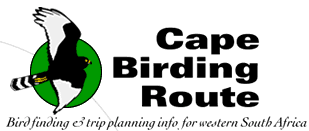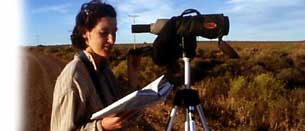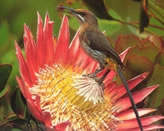Strandfontein
Sewage Works
Although the uninitiated will often turn up their noses at the
idea of voluntarily visiting a sewage farm, such places are
often exceptionally rich in birdlife. This is especially true
of the extensive Strandfontein sewage works, arguably the best
waterbird locality close to Cape Town, whose existence is under
threat from a new motorway. The abundant and diverse birdlife
makes it an ideal destination for the beginner and serious twitcher
alike, and it is possible to see more than 80 species on a summer
morning. A major advantage is the opportunity to bird from the
comfort and security of your car, which can be used as a moving
hide. The vast network of reed-fringed pans which radiate out
from the sewage plant buildings is connected by good gravel
roads, but beware of occasionally treacherous sandy patches,
especially along the southern coastal road.
To
enter the Strandfontein sewage works from the Cape Town side,
take the M5 free-way southwards from Cape Town and turn left
into Ottery Road at the Ottery turn-off; continue for 4.5
km until the junction with Strandfontein Road (M17); turn
right here, and continue (southwards) along Strandfontein
Road for 4 km; turn right again at the ‘Zeekoeivlei’
sign (1 on site map, opposite) within a stand of gum trees
just after a petrol station and opposite Fifteenth Avenue.
To enter the works from the False Bay side, turn north onto
Strandfontein Road from Baden Powell Drive, 6.8 km east of
the Muizenberg traffic circle, and you’ll reach the Zeekoeivlei
turn-off after 4.1 km.
Baden
Powell Drive (R310) follows the False Bay coast westwards
to Muizenberg and Simon’s Town, and eastwards to the
N2 highway near Somerset West. Strandfontein can thus conveniently
be visited after Sir Lowry’s Pass (p.60).
The
poorly marked entrance to the works is adjacent to a derelict
building at the south end of Zeekoeivlei (2), where African
Fish Eagles are often seen roosting in the trees to the
west. Bird numbers and water levels at Strandfontein vary
widely depending on the year and season, and the route suggested
below is intended as a general guide to the most productive
areas.
Continue
along the tar road towards the plant buildings, and check
the deep pans on both sides of the road (3 and 4) for Black-necked
Grebe, Maccoa Duck, Southern Pochard, and
Cape Teal. Here too you will see the first of various
other waterfowl species that are common throughout the sewage
works, such as Cape Shoveller, Yellow-billed Duck
and Red-billed Teal, while Purple Gallinule
stalk along the reed-lined edges. Levaillant’s Cisticola
is very common in long grass fringing the pans, and agitated
birds draw attention to themselves with their characteristically
frenetic calls. White-throated and European Swallows
(summer) and Brown-throated Martin dart low overhead.
Where
the road meets the sewage plant itself, continue to the left
of the buildings, and scan pan 5 for a good variety of waterfowl.
The adjacent small, muddy pan at 6 often host somewhat scarcer
species such as Southern Pochard and Wood Sandpiper.
The road between the two pans is regularly used in summer
as a roost by large numbers of White-winged Terns,
which can be seen flying over pans throughout the area.
At
this point, retrace your route and continue to the pan at
7. This pan, and the small, reed-enclosed pond at its northern
end, are usually also productive. At the ‘hub’ of
the wheel of large pans, turn left. Pan 8, on your right,
invariably holds good numbers of birds, notably Black-necked
Grebe, White Pelican, Greater Flamingo and
Maccoa Duck.
The
western and northern corners of pan 9 are always worth investigating.
The former often has an exposed beach frequented by waders
(including Avocet); the latter is good for scarcer
ducks such as Cape Teal and South African Shelduck,
and occasionally Hottentot Teal. Continue around the
northern apex of pan 9 and head south past pan 0. The reeds
in this vicinity are particularly good for African Sedge
Warbler, Cape Reed Warbler and, in summer, African
Marsh Warbler. Very much more evident in the alien thicket
are Cape Francolin and Cape Bulbul. Pan 0 itself
usually offers great birding, providing a good selection of
waterfowl and wading birds in its northern reaches.
Options
are now limited by sandy roads, so we suggest that you retrace
your route and turn left along the southern border of pan
9. This is an especially good area for African Marsh Harrier,
which is virtually guaranteed to be seen flying low over the
alien thicket and adjacent reedbeds. Head south again, and
cast a glance over pan A for African
Black Oystercatcher. Turn right where the road meets
the coastal dunes, where Swift and Sandwich Terns
and Little Stint (summer) often roost. Spare a moment
to look up from your telescope and enjoy the splendid view
over False Bay and its embracing mountains!
Good
numbers of waterbirds can reliably be found on pan B. Cape
and White-breasted Cormorants, White Pelicans
and miscellaneous waterfowl roost on the large, sandy island
and on the pan edge (C on map), while rafts of assorted ducks
bob on the usually choppy water. A pair of South African
Shelduck often frequents this pan, as do flocks of Greater
Flamingo.
Having
absorbed all pan B has to offer, continue past a series of
relatively unexceptional pans before re-entering the central
wheel at E. The small pan at D is often productive, as is
E. Before leaving, you might find it worthwhile to check pan
F for Great Crested Grebe.
|


